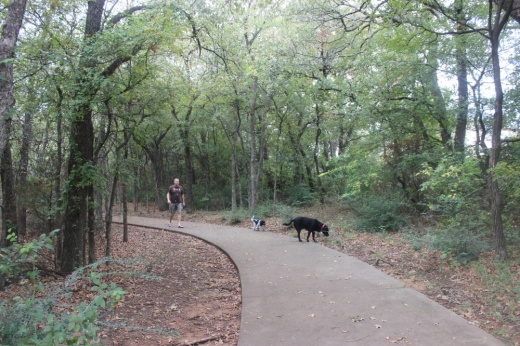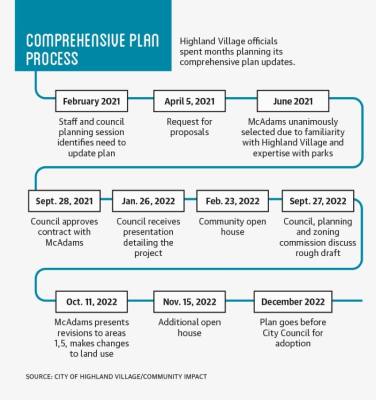Mayor Daniel Jaworski said the comprehensive plan is like a “vision statement”—it will guide the city on how to manage its parks, trail system and remaining undeveloped land in the future. Council expects to vote on the updates in December or January.
That undeveloped land represents about 3% of the city, and according to City Manager Paul Stevens, that was the major catalyst for looking to update the plan.
“For several years now, the council has been looking at the point where the city is going to be built out, because we’ve got 70 acres remaining,” Stevens said. “What happens then is you go into maintenance mode. You don’t have new property tax revenue coming in, so you’re dependent on assessed values increasing and sales tax.”
On top of the necessity to maximize the city’s remaining land, Jaworski said the comprehensive plan was due for an update.
“The plan we’ve been operating off of is well over 20 years old,” Jaworski said. “It’s only about 26 pages, and it’s guided the city well, but I would say it’s not as visionary as what the 21st century requires.”
A draft for the updates was presented to City Council by McAdams—the company handling Highland Village’s comprehensive plan—during a joint meeting with the planning and zoning commission Sept. 27. Additional changes to the plan were shown during the council meeting Oct. 11.
That draft breaks Highland Village’s undeveloped land into six “opportunity areas,” outlining recommended future uses for those areas.
Four of the opportunity areas are located on or near the southern border of the city, while one is located in the northwest corner by Brooks Court, and the last one is located in the northeast corner near I-35.
“The first thing we did was look at the characteristics of each of those areas. What was adjacent? What’s the topography? What utilities do we have, and will they need to be extended?” said Randi Rivera, McAdams director of planning and entitlement. “We had to take all of these conditions into consideration first, and then there was a market assessment done about what type of demand was in the marketplace for certain uses.”
The council was expected to vote on the comprehensive plan update during its Oct. 25 meeting, but the draft was met with backlash from the community, largely due to the recommended land uses in certain opportunity areas.
‘Tapping the brakes’
Residents packed into the Highland Village Council Chambers on Oct. 11 to express their concerns over the drafted plan.
One resident was Scott Caldwell, who lives near opportunity area No. 1—the 35.4-acre area in the northwest corner of the city. Caldwell, and several of his neighbors in attendance, expressed concern over the plan allowing high-density residential uses, which would allow multifamily units.
“I’m not anti-development; I’m anti-bad development that ends up as a tax burden for the city,” Caldwell said at the Oct. 11 meeting.
The city and McAdams hosted about 200 residents at previous open houses, and received over 600 survey responses and feedback from around 100 residents online throughout the process. But after the Oct. 11 council meeting and other community interactions, Jaworski and the council decided to slow down the process, scheduling another open house for Nov. 15.
“What we realized is we kind of lost control of the narrative in this conversation,” Jaworski said. “We discussed tapping the brakes and giving the public an opportunity to see the latest updates to the plan, and just pulling the curtain back on why we’re having these conversations.”
McAdams also used feedback to change some aspects of the draft.
Some of the changes included removing “high-density residential” as a recommended land use on any of the opportunity areas, defining terminology more clearly and removing specific, hypothetical layouts.
“We’re not trying to nail down any specific layout on these; we’re just trying to show a list of the best uses that will create the highest tax revenue for the city,” Rivera said.
Jaworski said the Nov. 15 open house, which had 89 residents attend, was “really positive.”
“There were some people that came that hadn’t even been a part of the conversation up to now,” Jaworski said. “There were some people that came that were very skeptical of what this all involves and I think they had constructive conversations with the people from McAdams as well as those of us in the city.”
Enhancing the trails
Along with the opportunity area uses, the update includes enhancements to the city’s parks and trail system, with 10 miles of proposed trails and 4.1 miles of proposed bike lanes.
Rivera said the trail system was a major priority for McAdams, because “the connection to nature” is what draws people to Highland Village.
Phil Lozano, the city’s director of parks and recreation, said Highland Village’s parks and trails serve as an economic asset to the city.
“The parks and trails provide great economic opportunities for the city as a whole, especially when you can connect residents to the business community and other points of interest throughout the city,” Lozano said. “We looked at this as an opportunity for a refresh, to bring in some new trends in parks and recreation so we can have that user experience [be] a little bit better than it was.”
Kathryn Zeringue, senior bicycle and pedestrian planner for McAdams, said improving the connectivity within the city’s trail network was a major focus of the plan.
“Our main goal was to expand on the existing network and then fill in those critical missing links to fully complete the trail network,” Zeringue said.
Zeringue said the addition of more bike paths will improve safety for pedestrians.
“A lot of community members said that a key barrier to trail use was the lack of safe biking and walking to trail and park facilities,” Zeringue said. “So another key part was improving safety along some of the major roadways.”
What is next?
Barring a few possible “tweaks,” the Nov. 15 version of the plan will be the one that council will vote on in December or January, according to McAdams Senior Landscape Architect Ron Stewart.
The plan would serve as a guide for the future of the city, but Stevens said residents should not expect to see any major changes to Highland Village.
“I’ve heard people say they don’t want Highland Village to change, and when you’re talking about 97% developed, you’re really not going to change much,” Stevens said. “We are trying to maximize the sales tax base and the property tax base so we can continue Highland village as it is.”
Jaworski added, despite the comprehensive plan changes, he expects Highland Village’s values to remain intact.
“There are parts of Highland Village that aren’t the same as they were in 1978, but in many ways, it is still the same city. The values are still the same,” he said. “Let’s look at our history and see that there have been opportunities; there have been moments where we had to make some tough choices about where our city goes, but every single time we’ve gotten it right.”









